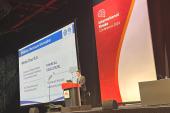ASSET-IT: Tirofiban Boosts Outcomes After IV Thrombolysis for Acute Stroke
Citing a low hemorrhage rate and other issues, one expert says the results should be replicated before changing practice.

HELSINKI, Finland—Adding IV tirofiban improves functional outcomes among patients undergoing systemic thrombolysis for acute ischemic stroke within 4.5 hours of symptom onset, results from the randomized ASSET-IT trial indicate.
An excellent functional outcome—modified Rankin Scale (mRS) score 0-1—was achieved in 65.9% of those who received adjunctive tirofiban and 54.9% of those who received placebo (adjusted risk ratio 1.18; 95% CI 1.06-1.31). Though symptomatic intracranial hemorrhages were more frequent in the tirofiban arm (seven vs zero), the rate in the treatment arm was low (1.7%).
Wei Hu, MD (University of Science and Technology of China, Hefei), and Jeffrey Saver, MD (UCLA Health, Los Angeles, CA), reported the findings last week at the European Stroke Organisation Conference (ESOC) 2025.
“We conclude that early administration of tirofiban following intravenous thrombolysis significantly increased the likelihood of disability-free and functionally independent outcomes at 90 days,” Saver said. The infrequent occurrence of symptomatic hemorrhage overall suggests “that the combination of tirofiban with thrombolysis has a favorable enough safety profile to permit overall benefit.”
But Pooja Khatri, MD (Yale School of Medicine, New Haven, CT), provided a cautious interpretation of the findings, noting that a prior trial—MOST—evaluating the impact of another glycoprotein IIb/IIIa inhibitor, eptifibatide, in patients receiving IV thrombolysis for acute stroke failed to show a benefit.
Moreover, Khatri indicated concerns with the very low rate of symptomatic intracranial hemorrhages, including none in the control arm, and the low rate of asymptomatic hemorrhages (under 4%) overall in ASSET-IT.
“That doesn’t mean it’s not true, obviously, but it’s just unusual,” she said. “I don’t know what to make of that. I’d want to see another study just because the data don’t really go with what I would’ve expected.”
The ASSET-IT Trial
Though IV thrombolysis with alteplase or tenecteplase is a standard treatment for acute ischemic stroke, reocclusion remains a common issue. Multiple trials have explored the possibility of using adjunctive antiplatelet therapy to improve outcomes. Aside from MOST, the ARTIS trial showed that early use of IV aspirin didn’t affect functional outcomes but did increase the rate of symptomatic intracerebral hemorrhage. More recently, the TREND trial indicated that adjunctive tirofiban reduced the risk of early neurological deterioration without increasing bleeding in patients with noncardioembolic strokes who presented within 24 hours.
To explore the potential utility of tirofiban further, Hu, Saver, and colleagues conducted the ASSET-IT trial at 38 comprehensive stroke centers in China. The study included patients with acute ischemic stroke who presented within 4.5 hours of symptom onset, were treated with IV thrombolysis, and were not scheduled to undergo endovascular therapy. Investigators randomized 832 patients (median age 69 years; 64% men) to receive IV tirofiban or placebo on top of systemic thrombolysis. At baseline, median NIHSS score was 6 and median ASPECTS was 10.
Treatment times were similar in both groups. IV thrombolysis involved alteplase in about three-quarters of cases and tenecteplase in the rest. In the treatment group, tirofiban was given as a continuous infusion at a dose of 0.4 μg/kg/min for 30 minutes then at a maintenance dose of 0.1 μg/kg/min for 23.5 hours.
The primary endpoint was an excellent functional outcome at 90 days, which was achieved at a higher rate in the tirofiban arm. Results were consistent across subgroups defined by age, NIHSS score, cause of stroke, time from onset to administration of the study drugs, baseline ASPECTS, and type of thrombolytic.
Among secondary outcomes, tirofiban also increased the proportion of patients who achieved functional independence (mRS score 0-2) at 90 days (80.4% vs 72.7%; risk ratio 1.11; 95% CI 1.03-1.19) and an excellent outcome according to the Barthel Index at 90 days (77.1% vs 70.5%; risk ratio 1.09; 95% CI 1.01-1.19). There was no difference between groups in health-related quality of life.
In terms of safety, the 90-day mortality rate was not significantly different between the tirofiban and placebo groups (4.1% vs 3.8%; risk ratio 1.07; 95% CI 0.55-2.09).
Some Considerations
Saver said several issues are important when considering the positive results of this trial in the context of prior negative studies that evaluated the combination of antiplatelet therapy and IV thrombolytics.
For one, ASSET-IT excluded patients with atrial fibrillation and focused on patients likely to have intracranial atherosclerotic disease (ICAD), he said. “Antithrombotic therapy is likely more important because the occurrence of reocclusion is likely more frequent when the underlying occlusion is related to intracranial athero.”
In addition, patients who were slated for endovascular thrombectomy were excluded. “That’s because ICAD is very frequent in the Chinese population, and many of these patients would need immediate angioplasty or stenting during the period of the endovascular procedure, in which case they would need antiplatelet therapy to manage the stent and the control group would therefore end up receiving active antiplatelet therapy,” Saver explained.
That exclusion also resulted in a trial population with milder deficits compared with what has been seen in prior trials, a characteristic that contributed to the safety of tirofiban, he said. He noted that compared with other antiplatelet agents, tirofiban “has a faster onset and faster offset, which makes it particularly pharmacologically well suited for this use case.”
Some of the unique aspects of ASSET-IT, such as the low hemorrhage rates, the exclusion of patients undergoing thrombectomy, and others, highlight the need for replication of the results, Khatri said, adding that the study should not be used to support changes to practice. “Not at this point, especially when it runs so counter to everything else,” she said.
Todd Neale is the Associate News Editor for TCTMD and a Senior Medical Journalist. He got his start in journalism at …
Read Full BioSources
Hu W, Saver JL. Advancing stroke safety and efficacy through early tirofiban administration after intravenous thrombolysis: the ASSET-IT randomized clinical trial. Presented at: ESOC 2025. May 21, 2025. Helsinki, Finland.
Disclosures
- Saver reports consulting fees for advising on rigorous and safe clinical trial design and conduct from Abbott, Acticor, Aeromics, Amgen, Argenica, Astrocyte, Bayer, Biogen, Boehringer Ingelheim, BrainsGate, BrainQ, CSL Behring, Filterlex, Genentech, Johnson & Johnson, MindRhythm, Medtronic, NeuroMerit, Neuronics, Novo Nordisk, Occultech, Phenox, Philips, QuantalX, Rapid Medical, Roche, and Stream Biomedical.
- Hu reports no relevant conflicts of interest.





Comments